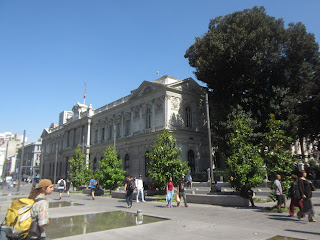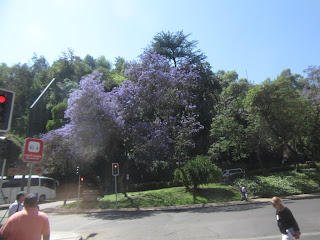We just had one full day in Santiago before jetting off the next morning to visit the amazing Easter Island for several days. That was why we decided to join the 'free' walking tour that started in Plaza de Armas that we had walked through yesterday on our arrival from San Pedro de Atacama.
Prior to the Spaniards' arrival in Santiago, this area had been an Inca settlement. This monument on the square honored the Mapucho indigenous people in Chile who were known as the 'sons of the earth.'
Felipe, our guide, said the square, literally Weapons Square because citizens had to bring their arms there to defend the city, was the heart of Santiago. Felipe said there were seven million people in the capital and another five million elsewhere in Chile.
The city's most important buildings were built during its colonial period. It took one hundred years to build the Cathedral as there had been eight earthquakes since it was first constructed.
Another view of the fanciest Post Office to be found anywhere! It had been the former Presidential Palace.
A sculpture of Santiago's founder, Pedro de Valdivia, who had been obsessed with building a 'golden city' in 1541 was in front of the magnificent City Hall. The colonial city hall and jail, built in 1552, survived until a devastating earthquake in 1730. The current Italian Renaissance style building was erected in 1891.Prior to the Spaniards' arrival in Santiago, this area had been an Inca settlement. This monument on the square honored the Mapucho indigenous people in Chile who were known as the 'sons of the earth.'
In an effort to decentralize the capital, Felipe told us Congress was moved to the city of Valparaiso, 90 miles away, and a city we would visit later in our trip. This was the country's new Supreme Court.
On the opposite corner was the Museo Chileno de Arte Precolombino, which we would see later that day.
The former Congress building:
As we walked along one of the many paseos or pedestrian streets, Felipe pointed out Cafe Haiti, one of the more than 100 'cafes with legs' in the downtown area. He joked it should be known as Cafe Hooters as 'more was offered on the side.' Sometimes, the tour guides lose people on the tour there!
It was so odd seeing that Canada's Scotiabank had such a huge presence in Santiago as, when I was growing up in Ottawa, I don't recall its having been a large bank. Oh, how times change.
The Palacio de la Moneda and other government buildings lined the Plaza de la Constitución, Chile's most formal plaza. The stately La Moneda building itself was the largest building in the Spanish Americas when it was completed in 1807 and was a mint for about fifteen years. Though only one president, beginning in 1845, used the building as the official residence, it became the official center of presidential operations.
In 1970, Felipe recounted how Salvador Allende became the first democratically elected Socialist leader in the world. He nationalized the copper companies from all the foreign owners, provided free education through high school and took land away from the rich to give to the poor in his 1,000 days in power. Chileans talk of a different 9/11 - one that happened on September 11th, 1973 when Augusto Pinochet’s military forces staged a violent military coup against then President Allende. They bombarded the palace, and later that day Allende was declared dead. His death was very controversial - some said it was a suicide while others argued it was an assassination. The death has since been ruled a suicide, but dissenting opinions continue to this day. For several generations of Chileans, the images of La Moneda being blitzed under orders of General Pinochet in 1973 marked the beginning of a divisive period in the history of Chile.
Though Pinochet was only supposed to have been a temporary leader, according to Felipe, he was an absolute dictator for 20 years. Citizens were tortured and killed because they believed differently than the new leaders. Some, Felipe recounted, were hauled off in handcuffs and dropped from planes into the Pacific Ocean. During subsequent elections, people only had the option to vote yes or no for the country's leadership. As people thought there were cameras in the polling booths, results were 55% to 45% in support of the status quo. When Pinochet died in 2006, there was a state funeral that lasted for three days. Felipe commented that only now are wounds from Pinochet's reign of terror finally healing.
Felipe mentioned how commonplace strikes were in Santiago. That day, for instance, all the public museums' workers were on strike as well as the public workers whom we passed in front of the Department of Public Works.
Chileans love flags so much that if residents fail to fly one, it is illegal and people can be fined according the country's Constitution! When Chile became independent from Spain in 1810, the red in the new country's flag symbolized the blood shed in the fight for independence. The blue represented the Pacific Ocean, white the Andes Mountains, and the single star represented one nation and one togetherness.
In front of the Stock Exchange was another of the city's many charming fountains.
At the end of the paseo was the country's second largest university. Felipe remarked that in a country where the minimum wage was just $350 a month, the separation between the rich and poor in the country was based on who had higher education.
Felipe commented that living in Chile is like living at the bottom of the world because of the constant threat of tsunamis, bush fires, earthquakes, volcanoes, etc - everything but hurricanes, he halfway joked! Six months earlier, the mammoth Gran Torre Santiago building, designed by renowned Argentine-American architect Cesar Pelli whose creations include some of the world's tallest buildings, swayed SIX FEET on either side during a 6.9 earthquake!
Felipe encourages us to all try a Copihue, one of Chile's most famous drinks and traditional desserts made from corn, wheat and barley on the bottom with peach juice mixed with water on top. It certainly didn't sound very appealing but I tried it anyways. When I asked Felipe why there were as many as five pharmacies on a block, he said people self-medicate. The country has the highest rate of diabetes on the continent because of all the sugary confections.
The city's beautiful Opera House was a copy of Milan's La Scala opera house, one of the most famous in the world.
I found it fascinating when Felipe described the sculpture across from the Opera as he said the children who were playing/fighting represented competing countries, especially Chile and Bolivia who had fought against each other. Their battle resulted in Bolivia now being a landlocked country.
Across from the Opera was the Military and Social Club.
Interesting mural on the side of the building, don't you think? I wonder what the artist had in mind when he conceived it.
We were so lucky to visit Santiago in late November when the stunning Jacaranda trees were blooming throughout the downtown area. These were at the entrance to Cerro Santa Lucia or Santa Lucia Hill, a lovely park very close to downtown. Felipe said there was a huge pile of rocks in the park which honored the many indigenous Mapuche people who were killed on the Hill.
Felipe pointed out the lampposts as certain ones were painted either black and white or blue and red depending on the local football teams' colors.
Not far away was the ever so pretty, leafy Parque Forestal, the land left over after a canal was built in 1891. The 32-acre oasis was enormously popular with Santiaguinos ever since a bike path and playgrounds were installed.
The park's elegant, neoclassical Museo Nacional de Bellas Artes or Fine Arts Museum was at one end of the park. Due to the strike, it was unfortunately closed that day.
As we strolled through the park, Felipe commented that forty percent of Chileans smoke and that there were ten thousand homeless people in the city.
One of the biggest monuments in the park was the Fuente Alemana, a gift from Germany after so many Germans were encouraged to settle in southern Chile when locals didn't want to, according to Felipe. Chileans regarded Germans as being disciplined and wanted them to 'improve the race' and populate that area, especially as the climate was similar to Germany's.
As we left the park and walked toward the Bellavista neighborhood, Felipe pointed out Cerro San Cristobal, the fourth largest municipal park in the world. If we liked, we could either hike an hour to its summit or take an historic funicular which opened in 1925. Though we were in Santiago three separate times, we ran out of time and never did make it to one of the most popular tourist attractions in Santiago.
The Mapocho River:
Felipe gave us a few minutes to wander through the Bellavista craft stalls. There we discovered that lapis lazuli was the national stone, a stone also found in Afghanistan.
We walked through Patio Bellavista, an open-air mall that was full of small galleries and interesting shops.
The shops displayed lots of lapis lazuli items and jewelry.
Bellavista reminded me of Soho or Greenwich Village in NYC. Though it was an area that had faced financial struggles, it appeared to be in the process of revitalization.
The fascinating tour ended a few minutes later. What an insight Felipe provided all of us into his captivating city and country.
Next post: Visiting Pablo Neruda's home and more.
Posted on April 10th, 2018, from Littleton, Colorado.















































No comments:
Post a Comment